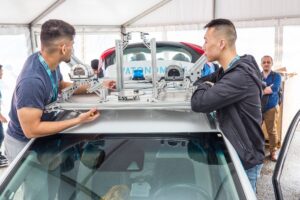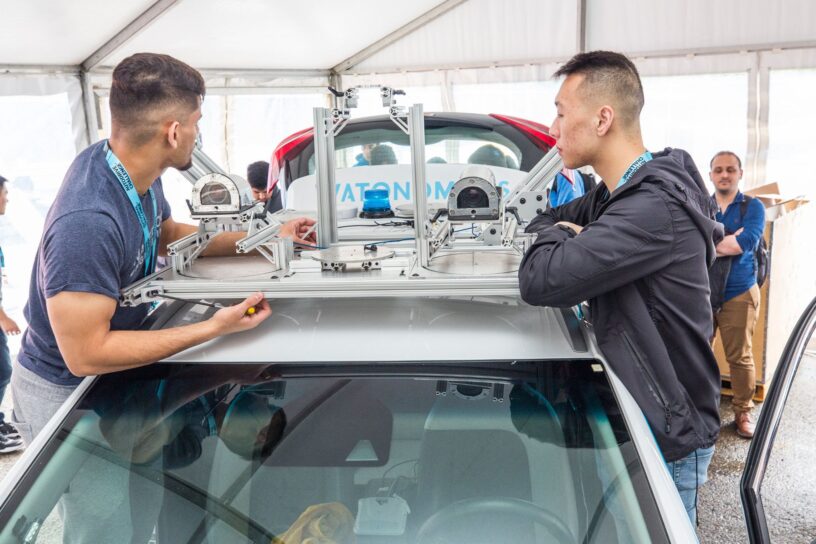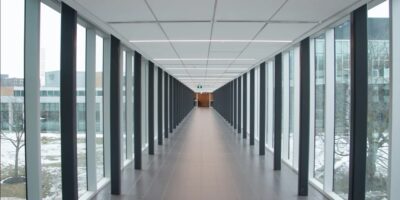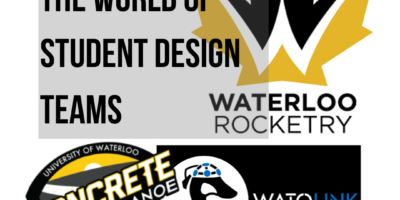I had the opportunity to video chat with Charles, a 3B Computer Science student and Team Captain of Watonomous, to discuss the team’s current and future goals, and how new students can get involved.
Tell me about what Watonomous does.
We start with a Chevrolet Bolt, just a standard electrical vehicle, and we’re converting it to a fully autonomous self-driving car. We do every single part of that: there’s a lot of work with mechanical, designing sensor mounts, modifying the car so that we can fit a server in the back, a lot of electrical work powering our sensors, lidar, camera, GPS, radar, etc. We have a business team that does marketing, outreach, sponsorship, getting all of the resources that we need for building this car. And then probably the biggest team is the software team that builds the core autonomous pipeline that controls our car. Path planning, perception, and simulation are the three groups within software.
What do you do at Watonomous?
I’m the team captain, which means I facilitate the team to accomplish our goals. Our main goal is to create an environment to teach students about autonomous vehicles. I started out in the path plotting group writing algorithms for how to drive our car. I moved on to leading a project within path planning, then becoming the technical leader of path planning, doing onboarding, teaching, and leading people that way, and now I’ve moved to team captain stuff along with the slowly growing scope of my knowledge and the knowledge I can share with the team as well. I find that my role as team captain is more facilitating other people to learn and do things. I spend a lot of my time helping people learn the software stack, learn background knowledge about autonomous vehicles, but of course I definitely still do contribute wherever I’m needed to our software stack.
What is your favourite part about Watonomous?
It’s got to be a split between the people and the resources we have. So in terms of the people, it’s amazing that we have a team of 65 incredibly dedicated undergraduate students, even through COVID. You don’t meet such a like-minded group of super smart and passionate people about autonomous vehicles anywhere else. For resources, it’s pretty insane how we’re a group of undergraduate students, but we have this unique access to over $300 000 of state-of-the-art equipment in terms of cameras, lidars, sensors, and compute resources. We have the ability to build some code and immediately just run that on the car and see it drive in real life, which is really special.
How would you describe the sense of community at Watonomous?
It’s a very tight-knit group. Watonomous is a bit more selective about who joins compared to some of the other design teams but that also means that there’s a bit more cohesion between groups because there’s a real commitment that we make when we say we’re working on Watonomous. Everyone here really cares about what we’re doing on the team, and really cares about doing well in our competition or learning whatever they can about autonomous vehicles. It’s a very collaborative environment. We like to facilitate and encourage people to ask questions and learn things as much as they can because we have so much knowledge. It’s a great place.

What have you learned from being a part of Watonomous?
What haven’t I learned? I started in software, with a baseline of knowing how to program, but Watonomous has really developed my programming skills and my coding style, into the level of a professional engineering style. I’ve learned a lot about robotics, electronics, stuff outside my domain, through sort of osmosis. I got exposure to machine learning, computer vision, and of course autonomous driving. Through my experience at Watonomous I’ve also had opportunities to work with research groups on autonomous vehicles, developing various packages or algorithms for their cars.
How has Watonomous adapted to the remote environment?
It’s not necessarily really doing amazing, it’s actually pretty surprising. There are no requirements for anyone to be on campus, they are wherever they want to be. We have 65 fully engaged students that are very passionate about the project. We’ve invested heavily in Compute servers located in Waterloo that can be accessed remotely so that students don’t have any hardware requirements or costs of their own. We’ve gotten a lot of funding from MEF, WEEF, and external sponsors to make this happen. We’ve acquired these servers with top, state-of-the-art compute power, like thread rippers, Nvidia 3090 GPUs for machine learning training and more so there’s a lot of resources for students. Of course, it’s a bit tough not being able to test, especially with the stay-at-home orders and the shut down of the university, with our actual car, but we’re excited that the university will be opening slowly and we’re excited to get back to testing on the road.
What testing have you been able to do remotely?
We also invested very heavily in simulation, which was a big effort last term. We’re able to run our entire software and electrical, anything that has to do with code, through the Unreal Engine Simulator with very realistic inputs. You can even run machine learning models for computer vision on Simulation, it’s pretty cool.
How can new members join?
New people who are interested should follow us on Facebook and apply on our website. We typically post on social media or update our website about a month before the term starts, which is when we start doing recruitment and interviews. The process is pretty chill I’d say, well maybe it’s not but, you apply, give your resume, answer a question or 2 about why you want to join Watonomous. We’ll take a look at your application and have a short 30-minute chat with you, getting to know you a bit and how you’d fit in the team.
Are most students in the Faculty of Engineering?
We accept students of all backgrounds and years. Typically, the majority of students who join are in second year after they gain some experience with whatever area they want to join for. But we also have some first years, fourth years, Master’s students, etc. It’s probably about half and half [Engineering and otherwise]: we also have a business team that does a lot of sponsorship stuff for us and finances, those guys are all from AFM or Math. Even within the software, mechanical, and electrical teams, we have some people that are from fields that you wouldn’t expect.
Anything else you want readers to know about the team?
We’re currently in the final stage of our four-year competition. Last year we did pretty well, we came 3rd place out of 8 total teams which was pretty awesome. This year we’re hoping to take first place and we’ll be competing at the Michigan Mcity test track doing autonomous drives.





Leave a Reply